Job Outlook 2014
Students often find an environmental, health and safety major is the perfect mix of science and helping people – so why aren't more aware that EHS is a career option?

Veteran EHS pros talk about how they got their start
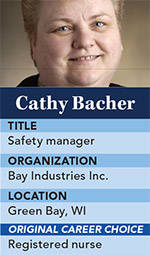 |
Cathy Bacher remembers the moment like it was yesterday: She was working as an emergency medical technician at a large paper company when her boss burst into her office. “They had an OSHA inspection that did not go well, so my boss dropped the citations on my desk and said, ‘Get us into compliance, but don’t spend any money,’” Bacher recalled. “That started my safety career.” It took five years for Bacher to change the safety culture from “miserable” to “strong” by using free online resources and training. She also recruited employees who were natural leaders for the safety program, realizing that others would follow their example. However, she said she made an early mistake by purchasing a canned hazard communication program. It failed – employees were not labeling chemicals, looking at Safety Data Sheets or wearing the right type of gloves. When Bacher talked to workers, she found that many spoke Spanish and could not read the posters and documents printed in English. She started over and developed signage using pictures rather than words. Bacher said that over the course of 30 years in safety, her medical training has been an asset because she understands how different exposures will affect the body. “I wouldn’t trade it for the world,” she said of being a safety professional. “This job is one of the few ones in the world where you can seriously make a difference in people’s lives for the better.” |
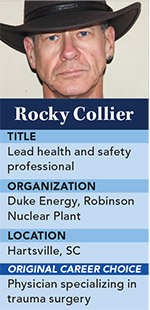 |
Rocky Collier credits his safety career to serendipity. He had no intention of applying to be a safety professional when he walked into a nuclear plant with a friend more than 22 years ago. In fact, he had already accepted an engineering position at a local fire department, and the only reason he filed an application was for his unemployment paperwork. The woman who took his application noticed he had not listed which position he was seeking, such as welder, pipe fitter or carpenter. “Through divine intervention or whatever, the words ‘safety man’ popped in my head and I told her I wanted to be the safety man,” Collier recalled. It turned out the plant had an opening for a safety person with first aid knowledge, and Collier’s prior experience as an emergency medical technician made him a perfect fit. Plus, the salary was higher than the job he was planning to start in a few weeks, so he changed plans. Collier said he had studied pre-med at Eastern New Mexico University, but he was not accepted into the first medical school to which he applied, so he became a firefighter and EMT instead. Looking back, he sees a direct connection between the career as a trauma surgeon he first envisioned and the one he now has in safety. “It’s all service; it’s all doing something for someone else,” Collier said. “Instead of trying to fix them up after they get hurt, I’ve evolved to helping to keep them from getting hurt.” |
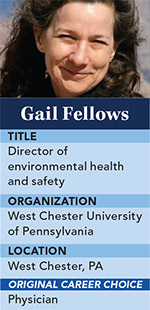 |
After earning a B-minus in zoology class her freshman year, Gail Fellows decided to switch from pre-med because the professor had said anyone who did not get an A should not go into medicine. She was not sure what to major in until her father, an aeronautical engineer who had become a safety professional, suggested she follow in his footsteps. “One day he came to me and said, ‘I think I know what you want to be,’” Fellows said. “Instead of saying ‘no you don’t,’ I listened and he said, ‘I’ll set up a meeting with an industrial hygienist who works for state OSHA. That way you can find out for yourself what it’s about.” After a day with the industrial hygienist, Fellows knew it was the field for her because it had the right mix of science, creativity, and working inside and outside an office. Most important, “it was helping people not get hurt, which was why I wanted to be pre-med in the first place,” she said. There was one problem, however: In the mid-1970s, OSHA was new and the University of Arizona did not yet have an industrial hygiene program. Fellows continued taking relevant courses while the university developed a program and was the first traditional student to graduate with the degree in December 1981. “I just had faith that it was really going to happen,” she said. “I often think if my dad hadn’t been in that profession, what would I be doing now because there was no indication while I was going through college that this field even existed.” |
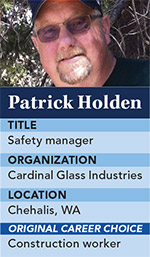 |
After 25 years in general and marine construction, Patrick Holden had to make a change. “It’s a young man’s game,” he said. “It just got to the point where physically it wasn’t working for me, so I had to do some soul searching.” He considered construction management, but decided against it because construction hiring was slow with the economic downturn. When he thought about which parts of his job he enjoyed most, the answer was clear: regulatory compliance and safety. Holden went to Centralia College to earn his associate’s degree in safety and was hired at Cardinal Glass Industries after graduating in 2009. He said he plans to enroll in a bachelor’s program. Holden said that over the course of his career in the construction industry, he has seen safety emerge as a true profession, as opposed to a generation ago when a construction worker was assigned safety duties. As he explained, a lot of older workers entered safety by way of “You’re the guy that gets hurt; now you get to be the safety guy, thinking that magically you’re going to be able to translate that experience into training and accident prevention.” For Holden, entering a degree program – not just learning safety on the job – was crucial, and he left with more than textbook knowledge. “I’m in my 50s and a lot of our workforce is much younger, and I think particularly the communication courses – and then just interacting with younger people – was a benefit for me,” Holden said. |
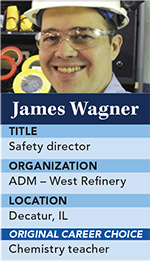 |
In his early 20s, James Wagner planned on becoming a chemistry teacher. That all changed when he started student teaching and encountered a few teens whose use of obscenities conflicted sharply with the values of respect and discipline he had learned in the U.S. Navy. Wagner switched to research, a career that would still tap his passion for science. After being deployed again, he came back intent on being a safety professional. He had seen up-close how skipping a step could cost someone his or her life, and he was comfortable learning and explaining rules and procedures. “The transition from military to safety is probably almost a natural fit,” Wagner said. “I want to spend time trying to make sure people go home the way that they came to work, and because of the unique perspective I have – whether I wanted to be exposed to it or not – I have seen the extreme of what happens when you can’t understand, communicate and follow simple rules.” Wagner sought out safety training with the help of OSHA employees who also were veterans. When a safety position opened up, he was ready. His strategy for reaching workers is to form genuine relationships. He likened it to being in the military, where everyone in uniform puts aside disagreements because they are on the same team with the same mission of making it home. At the end of the workday, “I stand outside at shift change and I watch everybody go out and everybody come in,” Wagner said. “And to me that’s no different than watching everybody get on the plane and watching everybody get off the plane.” It is a silent affirmation that he has made a difference because everyone returned home as they left – without injury. |
Share the story of how you got your start as a safety professional by adding a comment below.
> Next: More career stories
Post a comment to this article
Safety+Health welcomes comments that promote respectful dialogue. Please stay on topic. Comments that contain personal attacks, profanity or abusive language – or those aggressively promoting products or services – will be removed. We reserve the right to determine which comments violate our comment policy. (Anonymous comments are welcome; merely skip the “name” field in the comment box. An email address is required but will not be included with your comment.)

